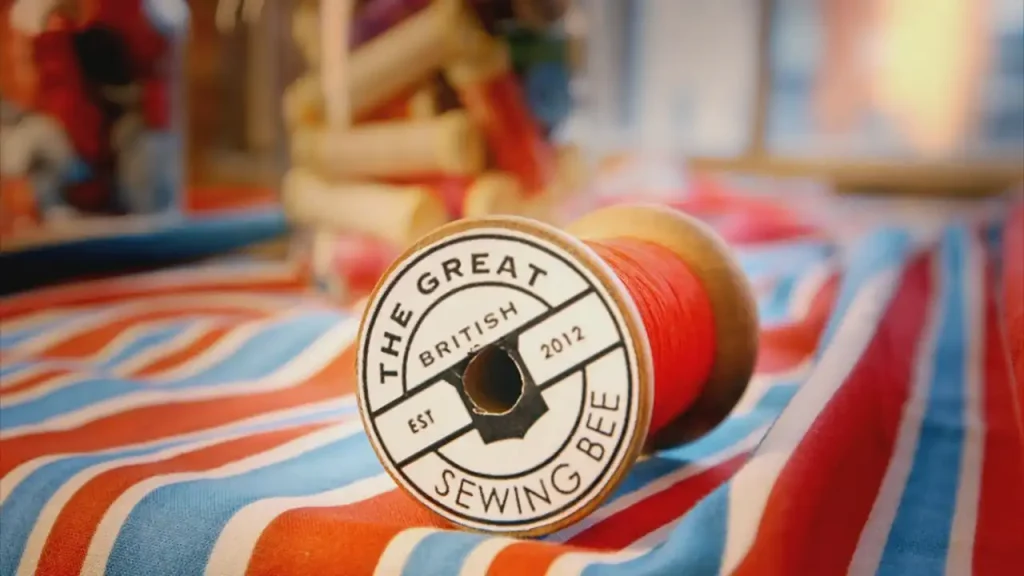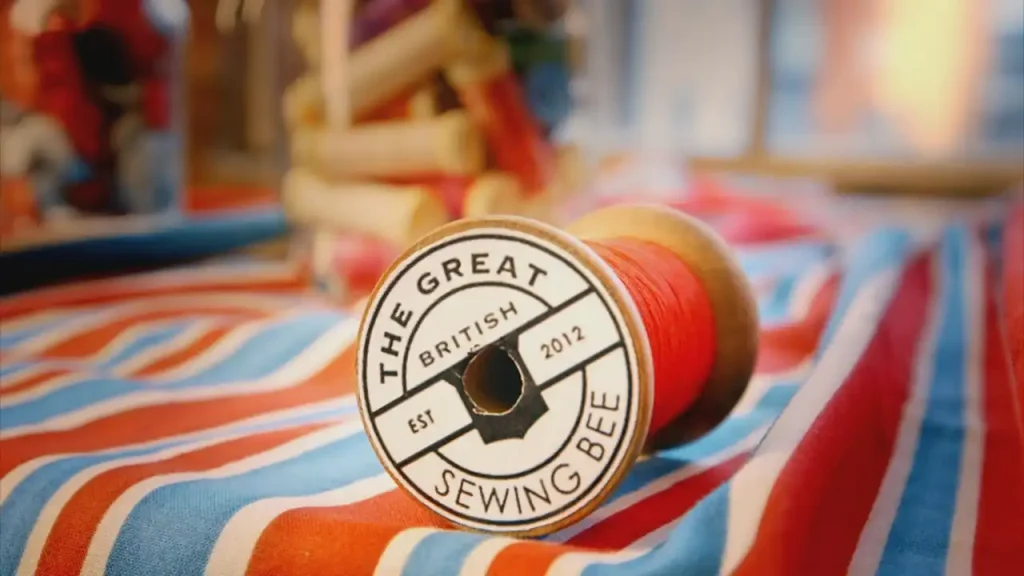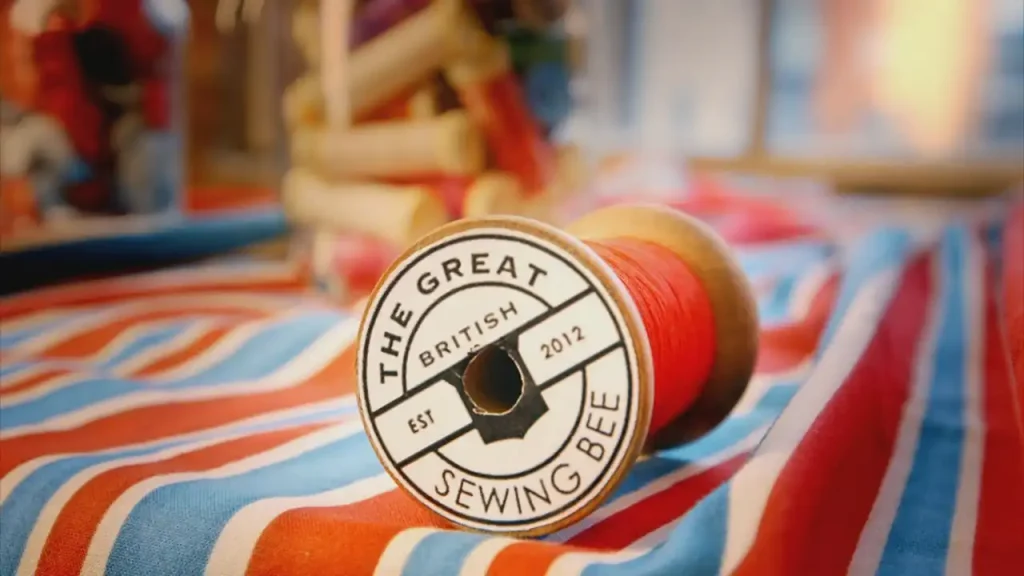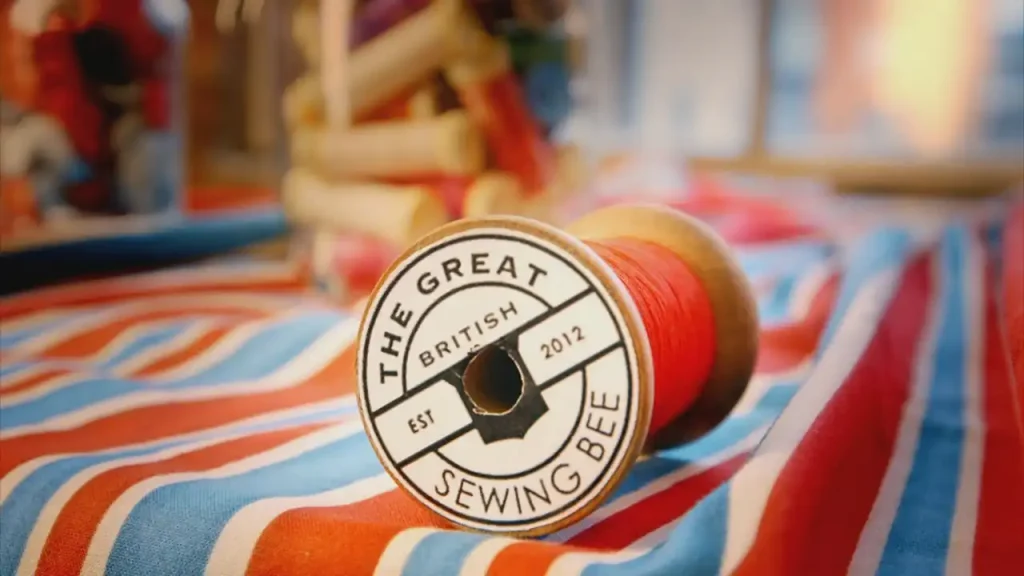The Great British Sewing Bee Season 5 Episode 3 – With comedian Joe Lycett at the helm, the remaining eight amateur seamsters embark on a time-traveling journey to the eclectic 1970s. The era is a rich tapestry of glamour, rebellion, and at times, utterly flamboyant styles. However, this venture involves far more than mere nostalgia. The contestants face the dual challenges of recreating some of the most technically demanding and aesthetically daring garments that the decade has to offer.
Kicking off the whirlwind trip, distinguished judges Patrick Grant and Esme Young set the stage with a task that is as groovy as it is challenging: crafting a pair of authentic flared jeans. This isn’t just any garment; it’s an iconic piece of fashion history that demands precision and skill. The sewers find themselves wrestling with vintage sewing machines and working with thick, heavyweight fabrics that are unforgiving of even the smallest mistakes. To add another layer of complexity, they must also tackle the notoriously difficult tasks of inserting a zip fly and executing a flat-felled seam—ideally without letting the pressure throw them into a tizzy.
For the transformation challenge, the workshop turns into a creative battlefield where the spirit of anarchy takes center stage. Fabric is flung, scissors snip wildly, and imagination runs rampant as the contestants reimagine t-shirts and tartan into audacious punk-inspired outfits. And they have to accomplish this feat of design and tailoring in just a mere 90 minutes, elevating the tension to palpable levels.
The climactic point of the episode is the made-to-measure challenge, which focuses on another quintessential ’70s icon: the maxi dress. Tasked with working with diaphanous, slippery fabrics that demand a deft touch, the sewers strive to create a garment that combines a form-fitting bodice with a floaty, ethereal skirt. The goal is to capture the inimitable glamour that has kept the maxi dress a wardrobe staple for decades. As the clock ticks down, the question that hangs in the air is poignant: Who will shimmy their way to being crowned with the coveted “Garment of the Week” title? And, on the flip side, for whom will the ’70s week become a poignant farewell, marking the end of their journey on the Great British Sewing Bee?
The Great British Sewing Bee Season 5 Episode 3 – A Groovy Trip Back to the 1970s
The 1970s. A time of bellbottoms, big collars, bold patterns, and a rebellious spirit. In episode 3 of season 5, The Great British Sewing Bee transported viewers and contestants back to this iconic decade. Hosted with panache by comedian Joe Lycett, the episode challenged the remaining eight sewers to revive the most technical, floaty, and anarchic garments of the 1970s.
The Flared Jeans Pattern Challenge: Strutting Their Stuff
To launch 1970s week with a swagger, judges Patrick Grant and Esme Young tasked the sewers with creating flared jeans from scratch. This high-pressure pattern challenge brought vintage machines, heavyweight denims, and perplexing construction techniques into play.
Jeans may look simple, but their engineering mystifies most home sewers. Making flares—with perfectly symmetrical scoop pockets, a sturdy zip fly, smoothly applied waistband, and neatly finished hems—demands technical precision. A perfectly constructed pair requires 13 pattern pieces and around 10 complex steps. The sewers also needed to choose fabrics with enough body to hold the signature bell-bottom flare.
As Patrick explained, the judges expected robust, medium-weight denims in classic blue or vibrant 1970s hues. Corduroy and needle cord came into fashion for flares, but their distinctive pile had to run vertically down trouser legs. Cutting against pile would make seams look different colors. Velvet corduroy was hugely popular, although its plush texture posed sewing challenges.
To construct the flares from waist to hem, sewers first attached front and back yoke panels to create legs. After joining the legs at center seams, scoop pockets were inserted before the intimidating zip fly. Waistbands and buttons finished them off. The trousers also required a flat felled seam, where raw edges are encased for durability. Neat parallel rows of topstitching finished off seams on the vintage machines.
This complex pattern left little room for error. But in just 3.5 high-pressure hours, could the sewers deliver impeccably constructed flares worthy of the 1970s?
The Punk Transformation Challenge: Anarchy on the Catwalk
After conforming to a strict jean pattern, the sewers let loose their creative spirits in the transformation challenge. Given 90 minutes, their mission was to turn t-shirts, tartan garments, and haberdashery items into provocative punk outfits.
Patrick set the scene by sending the sewers off to “pogo” to the haberdashery. This fast-paced challenge encouraged them to make bold statements with their clothing. The deconstructed, asymmetric punk look of the mid-1970s centered on rebellion and shock value.
With ripped seams, chaotic tartan, chains, padlocks, and liberal safety pins, sewers had to capture punk’s anarchic DIY aesthetic. Patrick longed to join in the punk chaos, but Esme knew her fashion label had helped birth this sensational street style. She remembered shocking the older generation with padlocked dresses and plastic straps.
Ideally, the sewers would also incorporate punk’s roots in military styles, using insignia to make anti-authoritarian statements. This was a chance to showcase their flair for improvisation, without relying on patterns or neatness. But could they create stand-out punk statements in just an hour and a half?
The Made to Measure Maxi Dress Challenge: Seventies Glamour
In their final nod to iconic 1970s style, the sewers faced the made to measure maxi dress challenge. With models for fitting, they had 5.5 hours to create perfectly tailored gowns from fluid fabrics like chiffon and Georgette crepe.
As Esme described, maxi dresses need close precision in the bodice, smoothly transitioning into a floor-skimming column of fabric. The distinctive 1970s silhouette depends on a well-fitted top and flowing skirt. Patrick noted that original vintage maxi patterns often used smaller sizing, so adjusting for a good fit was essential.
Many sewers opted for authentic patterns from the era, like Jen’s vibrant shoulder-padded design. Janet ambitiously used her own pattern from the decade. Meanwhile, Mercedes created a signature gathered yoke bodice matched with a loose elasticated waist.
Handling delicate Georgette to create flattering cowl necklines and fluttering flounces tested sewers’ technical skills. Gathering several metres of slippery crepe into flowing skirts was equally demanding. But for a sensational seventies look, they had to combine figure-hugging bodices with perfect maxi skirts.
After a freewheeling transformation challenge, the sewers faced a finale requiring precision and patience. Could they perfectly balance flair and fit to create showstopping maxi gowns? Only time would tell.
The Flared Jeans Challenge – A Technical Triumph or Seventies Setback?
With just 3.5 hours for the flares challenge, the sewers scrambled to construct this engineering feat. The first hurdle was selecting fabrics with suitable weight and nap direction. Janet chose eye-popping needle cord while Leah opted for a subtler grey corduroy. Riccardo and Juliet took a risk with patterned fabrics, needing extra care in cutting and seam finishing.
Next came the make-or-break yoke attachment. Riccardo called this fiddly felled seam a “construction puzzle.” After folding and encasing raw edges, twin needles had to precisely topstitch the yokes to legs. Any wavering would ruin the trouser line.
Frustratingly for Mercedes, her yoke came out “an absolute mess” needing a time-sapping redo. And she wasn’t the only one struggling to nail technical aspects as the minutes ticked by. Janet had a “calamity” with her zip fly that failed to lie flat, while Leah’s topstitching earned a stern “neatness is important” from Patrick.
After joining the legs and adding pockets, the sewers raced to finish waistbands and hem flares before inserting buttons. Jen was the only one to check a real pair of jeans for construction tips. Her flares impressed the judges as neatly and properly made. Leah’s looked good too, but her failure to cut with the pile downgraded her to third place.
Despite his pocket woes, Riccardo snatched second place. Sadly, Mercedes’ poorly positioned zip and Ben’s uneven topstitching put them both near the bottom. As Patrick said, Ben’s work was “untidy in the most prominent of areas.” Could he recover in time for the made-to-measure round?
Pogo Off the Podium in the Punk Transformation
In a whirlwind 90 minutes, the sewers fought to transform basic garments into dramatic punk statements. But not everyone embraced this anarchic challenge. Janet saw it as her “inner punk coming out,” but Jen felt adrift, since punk “passed me by.”
Leah took inspiration from punk icon Debbie Harry with a racy corset and mini skirt creation. Riccardo chopped up a kilt with zips and slashes for trousers with shock value. Juliet envisioned herself as a quiet punk in frilled hotpants, but Patrick saw Mercedes, saying, “It’s always the quiet ones.”
Janet aimed high, trying to make a zipped mini skirt from sliced sleeves. But as time ran out, her struggles led Patrick to jokingly grade her a “D minus” for her wonky zip and unfinished outfit. Leah’s Debbie Harry ensemble clearly impressed the judges with its artful cutting and cheeky seams.
However, Riccardo once again amazed, snatching first place for ingeniously repurposing a kilt into fabulously chaotic trousers. The judges praised his clever cutting and arresting use of zips. Though Jen and Juliet’s efforts proved too prim and proper, four sewers succeeded in channelling the punk spirit, proving less can be more.
Maxi Dresses – Achieving the 1970s Silhouette
After a breakneck transformation challenge, the sewers had just 5.5 hours to create the perfect fitted maxi dress. Easier said than done, as fitting fluid fabrics is notoriously tricky. But accuracy was vital for a flawless 1970s silhouette.
Rushed measuring and adjustments soon spelled trouble. Alexei struggled with the many pattern pieces and darts needed to construct his dress and lining. Janet also ran out of time to finish her charming floral maxi’s hem.
Meanwhile, Jen persevered through shoulder pad placement woes to deliver a beautifully finished dress. Mercedes chose a clever yoked bodice for ease of fitting. And despite issues with his habits, Ben’s ambitious wrapped waistband paid off for a flattering effect. With gathered tiers and clever pleats, both proved strong technical skills.
But the star of the maxi dress round was Juliet. Her impeccably neat cowl neckline and fluttering flounces won high acclaim from Patrick and Esme. The delicate Georgette fabric in her flounced dress moved gracefully and suited the model beautifully.
Like music to Juliet’s ears, Esme declared her dress “really well done,” showing perfect modesty and seventies elegance. Though Alexei struggled with his lining, his clever darting achieved miraculous fit. But could he survive another bottom-three finish?
There Can Be Only One Winner – Selecting Garment of the Week
As 1970s week reached its dramatic climax, Patrick and Esme had the unenviable task of choosing one sewist for Garment of the Week. Their contenders included Transformation Challenge winner Riccardo, Jen for her flawless jeans, and Juliet for her divine maxi dress.
Riccardo seemed a strong candidate, given the judges’ unabashed love for his tailored punk kilt trousers. In Patrick’s view, this ingenious transformation was “really clever and cool.”
However, his jeans didn’t impress as much as Jen’s impeccable pair. The perfect fly, crisp topstitching, and precise construction showed her technical prowess. Jen proved she could handle denim’s complexities while still giving her flares authentic 1970s flavour.
But the showstopper maxi dress couldn’t be overlooked. Juliet’s gown combined delicate detail with a simple, flattering shape that encapsulated 1970s elegance. Her exquisite handling of the fluid fabric and ethereal flounces captivated Patrick and Esme.
In the end, one dress checked every box for fit, construction, and wearability. The judges awarded Mercedes Garment of the Week for her gathered yoke number. Its clever seventies twist on the maxi silhouette, teamed with impeccable sewing, made it a worthy winner. Mercedes was over the moon with her first Gold Medal.
Farewell to Ben – An Experimental Sewist Departs
With the highlight of Garment of the Week decided, the bittersweet goodbye remained. Despite creating some of the week’s most forward-thinking garments, Ben fell short on execution. Patrick felt he focused too much on “doing fabrications” without the time to perfect them.
Ben’s poor pockets and uneven pleats in the maxi dress disappointed, while his sloppy jean finishing sealed his fate. Patrick and Esme loved his creative spirit but felt his sewing skills lagged behind. Though sad to say goodbye, they agreed Ben’s below-par work left no choice but to send him home.
Departing graciously, Ben felt grateful for his time on the show. He vowed to continue pushing boundaries and remain “a bit unusual” in life, thanks to discovering his adventurous side. Though losing a talent like Ben was disappointing, at least he departed newly emboldened to keep experimenting.
Key Takeaways from 1970s Week’s Challenges
Through three very ’70s challenges, both judges and sewers learned some valuable lessons during their retro time travel:
- Technical fabrics require extra care. Corduroy and denim’s nap and weight impacted construction. Soft fabrics like Georgette demand perfect handling to avoid puckers or tears.
- Vintage patterns use very different sizing and finishing than today’s commercial options. Taking accurate measurements and fine-tuning fit is essential.
- Rushing leads to mistakes. Ben’s pleating errors and Mercedes’ zip woes showed that quality suffers when racing the clock.
- Patterns aren’t the only path to great garments. Craftily repurposing fabrics led to Riccardo’s winning punk look.
- Attention to detail makes all the difference. Juliet’s perfect finishing and neat seam allowances elevated her dress above the rest.
- Geometry matters, even in raucous punk. Clean angles and shapes flatter despite deconstructed styling.
- Garments should suit the model’s shape. Ill-fitting shoulder pads disrupted proportions on Jen’s dress.
- Being adaptable is crucial. The best sewers adjusted sizing, positioning, or styling on the fly to create success.
The judges definitely threw some curveballs during the pressure cooker of 1970s week. But the sewers learned to roll with the punches and sharpen their skills. Even without victory, clever concepts, tricky techniques, and perseverance through every decade’s challenges will serve them well in the competition’s second half.
The Competition Reaches Its Halfway Point
After bidding farewell to experimental sewer Ben, the remaining seven candidates have officially reached the halfway mark in the competition. For frontrunners like Riccardo and Jen, the chance to claim the final prize feels tantalizingly close now. But for those barely evading elimination like Alexei, crunch time has arrived.
The judges certainly aren’t making it easy, as hinted by their preview of the upcoming challenges. In episode 4, Patrick promises a pattern that will push sewers outside their comfort zone. Technical “performance” fabrics that behave unpredictably will also test their skills and patience.
But the sewers know surprises go hand in hand with success on The Great British Sewing Bee. Their ability to thrive under pressure and adapt techniques to unconventional materials will determine who makes the top three.
Those trailing the pack like Alexei must look deep within to find untapped potential. With his impeccable dressmaking and tailoring skills, he has every chance to bounce back. But the desire to evolve and impress must come from within.
Jen and Riccardo continue setting standards for originality and perfectionism. But competition is heating up, with Mercedes gaining momentum after her garment of the week win. Leah, despite floundering in the flares challenge, possesses the artistry to excel. And Juliet’s elegant maxi dress proves she’s a dark horse gathering pace.
The sewers also can’t forget that anything can happen in a quarter-final technical that trips up even consistent performers. In this tense halfway phase, focus, skill and embracing the unpredictable are everything. Those reaching the semi-final will need both style and substance to get ahead.
But one thing remains certain – with beach holidays out of reach, what better escape could there be from the everyday than getting engrossed in the contestants’ creativity and stories? Patrick and Esme wouldn’t miss this thrill ride for the world. And neither will the viewing public.
The Inside Scoop – Answers to Pressing Sewing Bee Questions
Who won The Great British Sewing Bee Season 5?
In a hotly contested finale, Jen Lawrence triumphed over fellow finalists Riccardo Melito and Leah Pritchard to win Season 5. The 42-year-old fashion designer impressed with her technical precision and fearless creativity throughout the season’s challenges.
Who was eliminated from The Great British Sewing Bee Season 5 Episode 3?
Men’s-wear designer Ben Moss was the unlucky third contestant eliminated in episode 3 after failing to impress in the flared jeans and made-to-measure maxi dress challenges. Judges felt his workmanship lacked finesse despite admiring his adventurous spirit.
What challenges were in The Great British Sewing Bee Season 5 Episode 3?
The sewers took a 1970’s time trip, undertaking a flared jeans pattern challenge, punk transformation, and made-to-measure maxi dress creation. Flawless pocket and zipper execution proved crucial in the jeans round, while resourceful fabric hacking won the punk challenge.
Is Joe Lycett married?
Comedian and presenter Joe Lycett is not currently married, and remains highly private about his romantic life. However, he has stated he identifies as queer. Joe maintains an ironic stage persona and often tells tall tales, so his personal details are hard to confirm!
How old is Joe Lycett?
If his frequent claims are to be believed, Joe Lycett was born anywhere between 1981 and 2008, making him somewhere between 14 to 41 years old. In truth, sources indicate he was likely born in 1988, making the comedian around 34 years old currently.
What is Joe Lycett’s net worth?
According to media reports, stand up comedian and TV host Joe Lycett has accrued a net worth of approximately £1.3 million. This is predominantly through his comedy tours, television appearances, and panel show performances.




